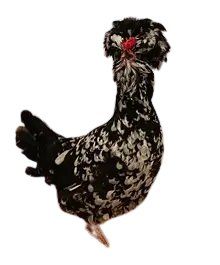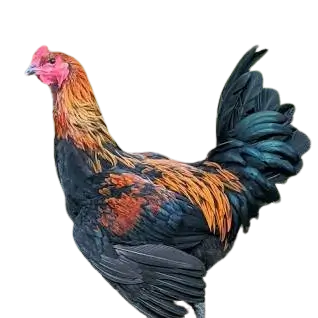Lamona chicken

Harry M. Lamon created Lamona chicken at the USDA experimental station in Beltsville, Maryland. Lamon combined three breeds – Silver-Gray Dorkings, White Leghorns, and White Plymouth Rocks – to create the Lamona chicken. He selected Dorkings for their meat quality and white skin, Leghorns for their egg-laying ability and red earlobes, and Plymouth Rocks for their size and vigor. He aimed to produce a breed with white feathers so the pinfeathers would be less noticeable on the dressed carcass. He combined his surname with the first two letters of his first name to name the breed after himself.
Lamona chicken is also known as Lamonas, Lamona Super-Chicken, or American Super-Chicken. The name Lamona comes from the name of the breeder, Harry M. Lamon. Super-Chicken was used to describe the breed’s dual-purpose qualities, as it could produce eggs and meat at a high level. The term American was added to emphasize the breed’s origin and suitability for the American market.
Types of chicken
Lamona chickens come in two varieties: standard and bantam. The American Poultry Association recognized the bantam type in 1960, while the standard type was recognized in 1933.
Colors
Lamona chickens are a breed that comes only in white. They have pure white feathers, which makes them attractive and easy to pluck. The skin, beak, and legs of these chickens are yellow, which American consumers prefer for meat. The breed is distinguished by its red earlobes, which are rare among white egg-laying breeds. In addition, Lamona chickens have a single comb and small red wattles that are less likely to develop frostbite.
Weight of male and female
The Lamona is a large, heavy breed with a well-rounded body and broad breasts. Its weight can vary depending on its type and age. The standard type of Lamona chicken usually weighs around 3.6 kg for males and 2.95 kg for females, while the bantam type weighs approximately 0.96 kg for males and 0.85 kg for females. However, it’s worth noting that the chicken’s weight can also differ based on its diet, overall health, and environmental conditions.
Annual egg production rate, egg color, and egg weight
Lamona chickens are known for their high egg production rates. They lay large white eggs with smooth shells, averaging around 60 to 65 grams in weight. Depending on the care and management of the flock, this breed can produce approximately 200 to 250 eggs per year. However, the actual number of eggs may vary based on the age and size of the hens.
Lamona Chicken Size
The Lamona chicken is a well-proportioned breed with a long and deep body, a broad and deep breast, and a full and rounded abdomen. The size of the cock and hen vary depending on the bird’s type and age. The standard type of Lamona chicken has a size of about 30 to 35 cm for the cock and 25 to 30 cm for the hen, while the bantam type has a size of about 20 to 25 cm for the cock and 15 to 20 cm for the hen. The size of the chicken can vary depending on its diet, health, and environment.
Yearly birth rate and life span of Lamona Chicken
The Lamona chicken is a breed that grows rapidly and can live for a long time. It has a high fertility and hatchability rate, and the number of chicks born each year depends on factors such as the quality and quantity of eggs, the incubation method, and the survival rate of the chicks. On average, a Lamona chicken can give birth to 150 to 200 chicks per year, but this can vary based on how well the flock is managed and cared for.
The lifespan of a Lamona chicken depends on various factors like its health, diet, and environment. Typically, this breed can live for about 8 to 10 years, but the lifespan can vary depending on the bird’s type and breed.
Breeding hints and tips
Breeding Lamona chicken is crucial in preserving and improving the genetic diversity and quality of this rare and valuable breed. Here are some tips to help you breed them successfully:
- Select the best birds for breeding based on their physical and productive characteristics, such as size, weight, color, comb, earlobes, feathers, skin, eggs, and meat.
- Avoid inbreeding as it can lead to genetic defects and reduced performance. Use different bloodlines or sources of birds and maintain records of the pedigree and mating history of the flock.
- Provide a suitable and comfortable environment for the birds, with enough space, shelter, ventilation, lighting, bedding, feed, water, etc.
- Monitor the birds’ health and behavior, and take measures to prevent and treat diseases or parasites that may affect them. Vaccinate and deworm the birds regularly, and isolate and quarantine any sick or injured birds.
- Manage the reproduction and incubation of the eggs to ensure that the eggs are fertile, clean, and well-stored. Use natural or artificial incubation methods and provide the right temperature, humidity, and egg-turning.
- Care for the chicks and provide adequate warmth, feed, water, and protection. Separate the chicks from the adults and keep them in a clean and safe brooder. Introduce the chicks to the flock gradually, avoiding stress or aggression.
General Characteristics
The Lamona chicken is a breed that has many positive features and advantages.
It is a dual-purpose breed that can produce eggs and meat at a high level, making it suitable for satisfying the needs and preferences of the American market. This breed can adapt to different climates, conditions, diseases, and parasites. It is also well-feathered to stay warm in the cold and has small combs and wattles that are not prone to frostbite. The Lamona chicken breed is calm and docile, easily handled and managed. It is also tolerant and friendly with other birds and animals and bears confinement well. The Lamona chicken is also a beautiful breed with pure white plumage, yellow skin, red earlobes, and a single comb, making it attractive and distinctive.






